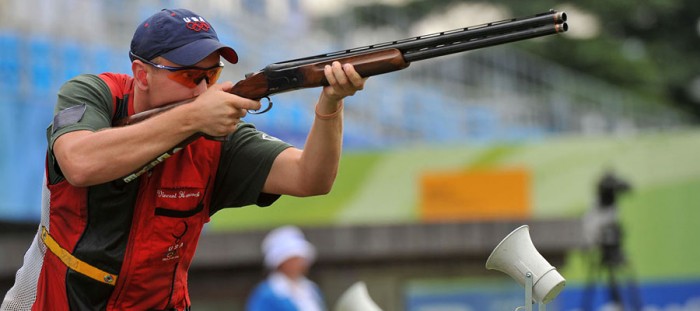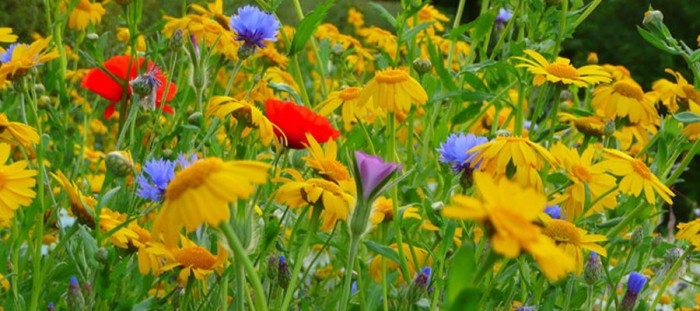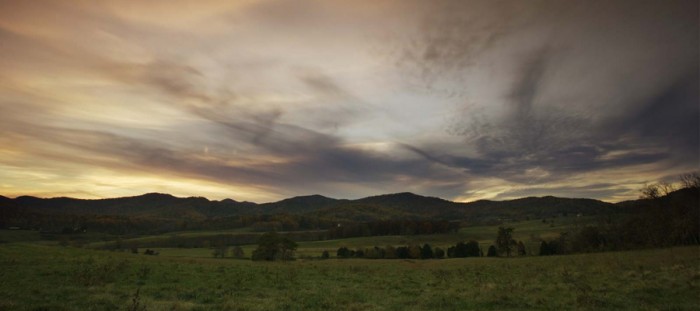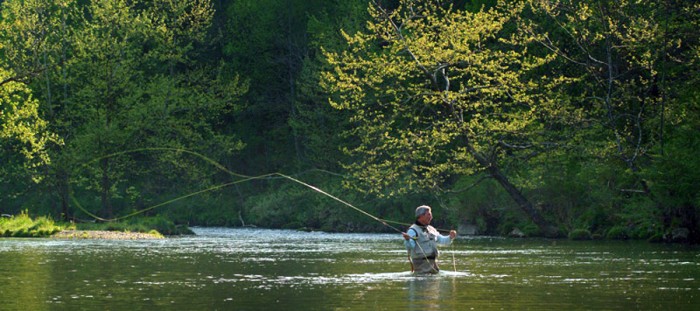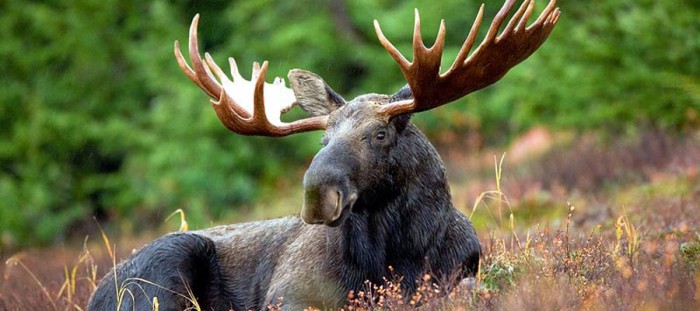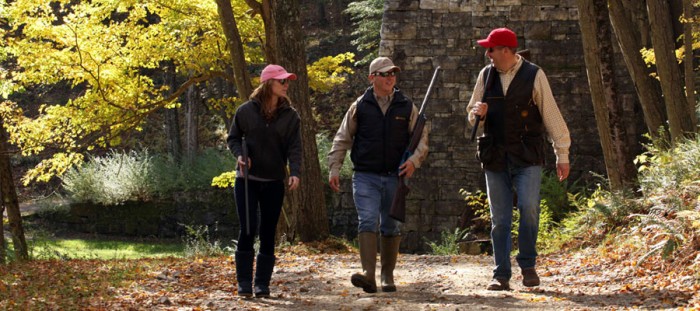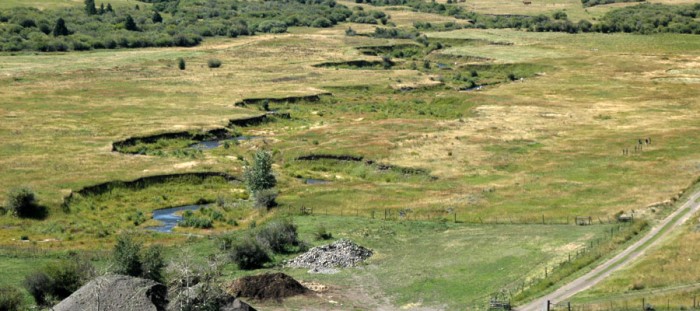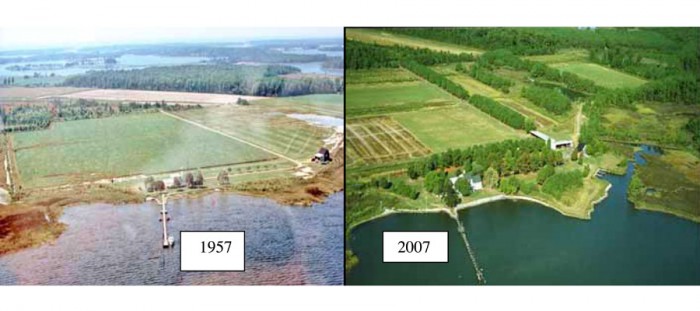The opening ceremony begins in a few hours. London’s Heathrow Airport has reported an increase of 47,000 daily passengers as spectators and athletes pour in from all over the world. In short, the 2012 Olympic Games are drawing near.
While we will certainly be watching as many of the events as we can, you can bet we’ll be glued to the TV during those sports closest to our hearts: shooting, archery, and equestrian. While we know that many of you are intimately familiar with these three sports, we thought it might be helpful to offer a quick overview of their structure for the rest of our readers.
Shooting:
The “shooting” heading actually encompasses 10 separate events, including a range of distances, shooting positions, and targets. In pistol and rifle events, competitors either shoot a specified number of shots at a stationary target within a certain time limit, or they may shoot at targets that briefly face the competitor and then turn away (example: Women’s 25m pistol).
As a way of engaging the audience, many of these events include a preliminary round and a final round. The preliminary round typically has a fairly large field and allows shooters to follow their own rhythm. Because it is often difficult for observers to follow the progress of this stage, a smaller field advances to a final round. In these final rounds, an official dictates the rhythm of the shooting. In each of these competitions, the scores from the preliminary and final rounds are totaled, and the winner is the competitor with the highest score.
On the shotgun side, events include trap, double trap, and skeet. In each of these events, competitors must shoot at moving clay targets. The machines that launch these targets are positioned at specific distances and are designed to launch the targets at a range of heights, angles, and speeds. Like their pistol and rifle counterparts, shotgun events often have final rounds composed of a smaller field. In these final rounds, the clay targets are often filled with powder that makes it easier for spectators to see when a target is hit.
Archery:
Unlike shooting events, archery in the Olympics includes both individual and team events. In both event styles, the distance from the archer to the target is 70 meters. Additionally, both styles are run in a tournament style with higher seeds facing lower seeds (much like NCAA basketball tournament).
In the individual competitions, 64 archers compete. The preliminary round begins with each archer shooting 72 arrows. They are then ranked by score and seeded for the single-elimination bracket. Once the bracket has been set, archers compete in head-to-head rounds with both archers simultaneously shooting 18 arrows, with the winner advancing. Once the field has been narrowed to eight archers, the format changes to 12 arrow matches with archers alternating by arrow.
In the team competitions, the same three individuals who compete for a country in the individual competitions compete as a team in a similar tournament style. Ranking is determined by combining the individual rankings from the individual competition. Matches consist of each team firing 27 arrows, with the winning team advancing to the next round.
Equestrian:
Equestrian at the Olympics includes three events–dressage, jumping, and eventing–with each event awarding both individual and team medals.
In the dressage competitions, the focus is on a horse and rider’s ability to perform a series of predetermined movements. Often considered the “ballet” of equestrian events, the top competitors successfully execute their movements smoothly and with incredible precision. Scores are assigned by a panel of judges who evaluate each competitor based on a number of factors, including the quality of the horse’s movement, the horse’s attention and confidence, and the rider’s seat and position.
The second equestrian event, show jumping, requires horse and rider to complete a series of 10 to 16 obstacles, with heights up to 1.6 meters and spreads up to two meters. Scoring is computed by calculating the number of faults each competitor sustains during the competition. Faults can be assessed for knocking down an obstacle, refusing to jump over an obstacle, and for exceeding the pre-determined time limit. The competitor with the best score (fewest number of faults) is the winner.
The last equestrian competition, eventing (or horse trials), is arguably the most grueling. Combining dressage, cross-country, and show jumping, the competition evaluates a horse and rider’s training, fitness, and ability to perform graceful and precise movements. The cross-country segment of eventing requires competitors to complete a long outdoor circuit composed of 30-40 obstacles. Scoring for eventing is based on a combination of time, faults, and judges’ evaluations.
Now that you can confidently call yourself an expert on these competitions, we are eager to know which competitors (both human and equine!) you’ll be following during these Olympics!
Imagine not spending your Saturday morning mowing the lawn. Think about the savings you could realize on your water bill if you didn’t have to water your lawn every day. Wouldn’t it be nice to know you were doing your part to reduce the amount of chemical fertilizer, pesticides, and herbicides entering our waterways?
Allow us to introduce you to the meadow.
All across the country, landowners are bucking the traditional, biodiversity desert that is the American lawn and are instead favoring a more natural approach. According to a recent Wall Street Journal article, “Partly it’s a backlash against traditional lawns, which get a bad rap because of the quantity of water, chemical fertilizer, and energy they tend to consume. ‘People don’t want to be associated with something that wastes resources and energy,’ [New York landscape architect Lisa] Switkin says.”
We wholeheartedly agree! With the greater biodiversity that meadows support, it’s hard to frown at the idea of looking out your window and seeing butterflies and wildflowers rather than a single shade of green. And with the range of seed mixes to choose from, landowners have an amazing array of options from which to design their ideal “lawn.”
But for sporting enthusiasts with larger properties, the benefits of a meadow landscape can be even more directly rewarding. Indeed, meadows serve as perfect habitat for some of our favorite upland game birds, like grouse, quail, and wild turkey (to name just a few!).
If you’ve converted your lawn, we would love to hear which grass and flower species you chose. And if you have photos, please post them on our Facebook page!
Photo Copyright: Jonathan Billinger
We thought that as a reader of our newsletters you might be interested in learning more about some of our work. Please click on the first four images below to view a series of “storybooks” that reflect our comprehensive approach to rural land planning, management, and development. The last two images will provide you with a portfolio of select projects as well as an overview of the philosophy and mission that serve as the foundation of our work.
We sincerely appreciate your readership and invite you to get in touch should you have any questions or if you are considering making improvements to your own property. And please consider passing these along to anyone you think might be interested in what we are doing.
All the best,
Bob McKee
Turn on CNN and you’re bound to hear a report about the economy. Flip over to Fox and they’ll be covering the same thing. Switch to MSNBC and yep, you guessed it, they’ll be talking about the economy, too. While everyone has their own take on how best to get out of this slump, it’s clear that something needs to be done.
How about investing in outdoor recreation?
According to Ken Salazar, Secretary of the Interior, hunting, fishing, and other outdoor recreation contribute over $730 billion to the economy each year. And one in twenty U.S. jobs are in the outdoor economy. To put that into perspective, that’s a higher proportion than for doctors, teachers, and lawyers!
Though these numbers are impressive by themselves, this growth in the outdoor recreation economy (estimated at about five percent each year) is catching the attention of many decision makers at the highest levels. Indeed, the Western Governors Association (WGA) has traditionally shown little interest in investing in public lands for purposes other than resource consumption. This year, however, Governor Christine Gregoire, chair of the WGA and governor of Washington, summarized the WGA’s position with the following statement:
“Outdoor recreation is critical to the West’s economy for more than just the opportunity to play in the great outdoors. It creates sustainable jobs and incomes for our friends and neighbors, especially in rural areas. It provides the opportunity to unplug from our busy lives, recharge our souls and live healthier lifestyles. The history and ethic of the West are tied to our lands and great outdoor places. Let’s build a world-class industry and recreational opportunities for Westerners and visitors to enjoy.”
Will you be traveling to a National Park this summer? Or perhaps heading to your favorite stand or stream? We’d love to hear how you’re contributing to the outdoor recreation economy!
If you bought a ticket in the hopes of winning the record-setting $640 million Mega Millions jackpot back in March, you probably have a pretty good idea what Alice Jenness of New Hampshire was going through last week. Only instead of hoping to win over a half billion dollars, she was holding her breath for the chance to hunt a moose.
You see, in order to control moose populations up in the Northeast, they hold annual lotteries for permits that give holders the right to take one moose each. However, because population control efforts have been so successful, combined with increased numbers of moose die-offs as a result of ticks, the number of permits issued each year has been steadily declining. Combine that with rapidly increasing numbers of entrants into the lottery system and the chances of winning a permit have become quite slim.
Indeed, over 13,000 people entered this year in the hopes of winning one of 275 permits. And, unfortunately for hunters, those numbers are likely to keep decreasing, according to wildlife biologists and other experts. In addition to the successful population control programs enacted by state and federal agencies, ticks and other pests are likely to become more and more common. In New Hampshire’s case, moose often carry up to 30,000 of the ticks at once during a normal year. However, whereas the ticks typically fall off and die in the winter snow, warmer winters have allowed ticks that fall off to reproduce instead. Now, moose in New Hampshire have been found to have over 120,000 ticks on them at one time, making them more susceptible to anemia and blood loss. And that can spell disaster both for moose populations as well as for hunters like Alice Jenness who will have the opportunity to hunt her first, and possibly her last, moose.
Heading to your local gun club is a great way to spend a day (or a weekend!). But it rarely leads to memories that you’ll be talking about for years. Sometimes, you just want that shooting experience that makes every other day pale in comparison. If this yearning is familiar to you, you should consider checking out the Dover Furnace Shooting Grounds in Dover Plains, NY.
Having received two Tridents from the internationally-renowned Beretta Trident Program, Dover Furnace has reason to boast a clay shooting facility that is second to none. Drawing its name from the 35-foot stone furnace that sits on the grounds, the facility masterfully combines a rich history with state-of-the-art equipment that makes for a truly unique experience. The grounds are expertly manicured and the staff is both extremely knowledgeable and happily ready to offer assistance.
And lest you think clays shooting is the only thing offered at Dover Furnace, it’s worth taking note of their upland bird hunting as well as their scrumptious dining options. From simple (and delicious) dining parties and barbecues to full-service weddings and banquets, the staff at Dover Furnace ensure that no matter how you spend your time, you’ll certainly be talking about it for years.
Photo courtesy of the Dover Furnace Shooting Club
All across the news, scientists, politicians, and pundits are warning of the need to protect our water resources. With historic droughts across parts of the southern and western parts of the U.S., many are already facing extreme water scarcity.
Though the culprits of issues with water quantity and quality are easily identified—over-development, pollution, climate change—the solutions are less clear. Larger dams ensure a larger water supply but they negatively affect downstream neighbors. Pollution regulations help to clean up waterways, but they can be expensive and difficult to enforce. Piping water longer and longer distances ensures water supply today but does nothing to address future challenges, while becoming increasingly expensive.
For years, the City of San Antonio attempted all of these fixes, each time finding itself facing the same challenges only a few years later. Realizing it had to address the root of the problem, the city partnered with The Nature Conservancy to protect the aquifers that feed San Antonio’s water supply. The city and The Conservancy approached ranch owners offering them the opportunity to put their land under easement in exchange for generous tax credits, funded by a voter-approved tax on consumer goods. Though landowners were at first hesitant to give up their rights to develop the land, they quickly realized easements could be the key to helping them hold onto their lands for generations to come.
Today, San Antonio and The Nature Conservancy, in partnership with many landowners, have conserved over 125,000 acres of critical land within the local aquifer. The effort has protected the area’s water supply into the foreseeable future and was accomplished at a much lower cost than traditional, infrastructure-heavy approaches.
We encourage you to read more about this collaboration among city officials, The Nature Conservancy, and landowners to preserve this important aquifer.
Check out this post from our affiliate, Blackburn Architects:
Today’s blog comes from Macy Carman, an enthusiastic and talented student (and equestrian!) from Hollins University in Virginia. Macy, an environmental studies major who is considering graduate studies in architecture, spent some time with us to learn about what it means to be an “equine architect.” In turn, my staff and I got to spend some time picking her brain about her invaluable experience as a groom for Pollard Eventing. (On a sad note, our thoughts are with everyone at Pollard Eventing. Macy travelled back to be with her horse family after the tragic car accident that claimed the lives of three horses last week.)
HERE’S MACY:
I knew I had picked the right architecture firm for my internship when John Blackburn started out my first day with what he referred to as his “dog and pony show.” I love pony shows! I am a lifelong rider, member of the United States Pony Club, and looking forward to a career in designing equestrian facilities, so I knew I was in for a treat. And I was…the presentation he showed me displays many of the options that are available to clients as well as the principles he bases his designs around: natural light and proper ventilation. I think that he could convince anyone that these are the most important concepts behind a facility!
During my time with the Blackburn team, I was able to accompany John to a Virginia Farm where he was interviewed for a video (stay tuned for the final project). After spending so much time discussing the process to designing a barn, I certainly had a different perspective when touring the facility. While my practical experience with horses, combined with time spent in a variety of barns, has instilled in me the importance of a well thought out facility for the safety and well being of the horse and rider, I picked up on a lot of smaller details. John had a reason for why every detail was exactly the way it was, and was happy to answer all of my questions. Watching his interviews, I got a sense that he cares for the horses just as much as the owners, which is exactly what we horse people are always looking for.
Over the course of my first week here, I have talked to everyone in the office about their projects, their academic paths, and their thoughts on barn design. As interested as I have been in barn design over the years, I have never given thought to many things Blackburn consistently addresses, like making sure that vehicles, visitors, and horses are separated at all times. Who knew a driveway needed so much planning? Everyone in the office has been very welcoming, and I hope that I have been able to provide a slightly different perspective as a rider and a groom. I look forward to absorbing a greater understanding of equestrian design during the rest of my time here- and maybe some tips on my graduate school applications too. I would like to thank the whole office for having me.
Have you been thinking about putting your land under easement but don’t want to give up control over it? Do you want to get a tax break for conserving your land but still want to be able to use it for hunting, fishing, and trail rides?
Conservation easements have long been an effective tool for enabling landowners to preserve their property. Unfortunately, many have shied away from diving in over concerns about giving up control over their land. We have talked with many landowners who were worried they wouldn’t be able to continue doing the things they love if they put their lands under easement.
Luckily, you can add a conservation easement to your land and still continue enjoying many of your favorite activities! Because of the way easements are written, landowners work with conservation organizations to determine which uses are and are not restricted on their property. Because easements are largely used to prevent further development, activities like shooting, fishing, and riding are typically approved uses of the land. Indeed, we have worked with landowners who put their land under easement and then generated revenue by selling access to their property for a range of sporting activities In the end, they were conserving their lands and making a living by doing so!
If you’re interested in conserving your property, we invite you to contact us and we’ll help you find the solution best suited for your goals. We look forward to hearing from you!
Picture this: It’s just before dawn. You’ve been in your blind for the past two hours. That mug of piping hot coffee isn’t as full as when you started this morning, but it’s done a nice job of keeping away the early-morning chill. Finally, the sky seems to catch on fire as the first rays of sunlight peak over the horizon. It’s going to be a good day.
If you just found yourself nodding as you thought back to your own experiences watching the sun rise from your blind, you’ll definitely appreciate this photo essay from Ducks Unlimited. Shot by Robert Lico, these photos truly capture the essence of those early mornings that you have to experience yourself to fully appreciate.
We hope you enjoy!

